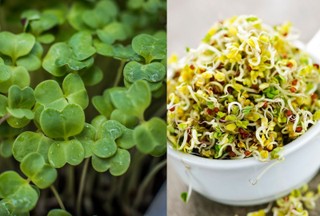Microgreens vs. sprouts: Growing, uses, and benefits

If you don’t know the difference between microgreens and sprouts, you’re far from alone. Both are juvenile versions of adult plants that have enjoyed their moment as darlings of the health food world, but they are as different from each other as they are from their mature counterparts.
Not to be confused with baby greens, which are basically adolescent greens, if a seed is an embryo, then microgreens could be likened to toddlers whereas sprouts are more like newborn infants. Read on for the lowdown on microgreens vs sprouts: what they are, how they’re grown, and what they are used for.
What are microgreens?
Microgreens are grain, herb, or vegetable greens cultivated in a growing medium and harvested within two weeks of planting–just before (and sometimes after) they develop their first set of true leaves. Microgreens pack far more nutritional value (1) into their tiny leaves than the mature plants they would grow into if allowed to. Initially popularized on cooking shows and in high-end restaurants, these diminutive superfoods can now be found on the shelves of many grocery stores and on windowsills everywhere.
The most commonly seen microgreens are kale, red cabbage, and broccoli, but literally almost any vegetable, herb, legume, or grain can be grown as a microgreen. Snipped off just above the soil at a few inches tall and sporting cotyledons or one set of true leaves (it depends on the variety), they add bold color and flavor to dishes.

Common microgreen growing methods
Growing microgreens is an excellent way to try your hand at gardening, even you have no experience. Getting started requires a few key components: a sunny location or a grow light, a growing container, some type of growing medium, a spray bottle, and organic seeds.
Growing Containers
Microgreens can be cultivated in any shallow vessel, and if you just want to experiment with growing, you can use a plastic clamshell, a pyrex pie pan, a casserole dish or any shallow type of tray or dish. For more intensive growing operations, you may want to invest in specially-designed trays. Beginners will probably do better with a container that has drainage holes, but they are not necessary, especially if you choose to water with a spray bottle.
Growing Medium
There are many different growing mediums that microgreens thrive on, but there are only two categories: soil-based mediums and soilless. Soil is exactly what it sounds like, but soilless mediums range from perlite and vermiculite or coconut coir mixes all the way to pre-formed growing mats that are cut to size.
Microgreen Seeds
As microgreens grow in popularity, there are more options available in terms of seeds. No matter where you source them, always seek out organic seeds, as the fact is that you will be ingesting these young plants and likely some seed husks as well. Arugula, buckwheat, cilantro, fenugreek, peas, and radishes are all popular seeds to experiment with. Most people find that microgreens taste a bit like the mature version of the plants their seeds want to grow up to be.
How to Harvest
Harvesting microgreens couldn’t be much easier. Once the seedlings have grown their cotyledons or first set of leaves, you can harvest by gently grasping the plants you want with one hand and trimming the stems just above the soil line with your other hand. If growing in a soilless medium, you can pull the plants out by their roots and give them a good rinse.
How to Store
The best way to store microgreens after harvesting is in a glass of water as if they were cut flowers. Place them in the fridge like this and they will last for several days at optimal freshness. You can also keep them in a plastic bag with a slightly moist paper towel. It is best to use them within three days of harvesting.
How to Use
Microgreens are nothing if not versatile. They can be tossed into a taco or swirled into a smoothie. You can add them to a salad or garnish a soup with them. The only thing you should not do is cook them, as this can reduce their potent nutrient and vitamin (2) content.

The enthusiast's guide to herbs
We’re proud to present our new e-book, The Enthusiast’s Guide to Herbs! Learn everything you need to know about growing and caring for herbs indoors, including in-depth info cards for the 35 most commonly grown herbs.
Click the link below to find out more!
What are Sprouts?
Sprouts are just-germinated seeds grown in a hydroponic (only using water) system that are harvested when they are a few days old. Unlike microgreens, sprouts are eaten whole–root, shoot, and leaves. Sprouts have been a health food staple for many decades now, and alfalfa sprouts and mung bean sprouts have been readily available at grocery stores since the 1980s.
Touted for their nutritional value, they were once a mainstay of raw diets, but have been overshadowed in recent years by microgreens. While the levels of beta carotene and vitamin c may be higher in microgreens, sprouts appear to have some anti-diabetic properties (3) and help to regulate blood sugar.

Common growing methods
Despite being harvested at an earlier growth stage, sprouting is a little trickier than cultivating microgreens. The main benefit of growing sprouts is that it is extremely fast– in the time it takes to grow one crop of micros, you can grow three rounds of sprouts. To get started, all you need are organic seeds, an appropriate vessel, and a few days.
Growing Containers
Sprouts are typically grown in glass jars or specialized containers where they can easily be soaked and rinsed once or twice a day. There are many types of screens available that are designed to be used with mason jars specifically for the purpose of growing sprouts. For some types of sprouts, you can even use a special bag that can be hung over the sink to drain. You can purchase our go to bag on Amazon.
Risks of eating sprouts
Commercially-grown sprouts have been the cause of some nasty outbreaks of bacterial infection in the past. The worst of these was an E. coli outbreak in 2016, linked to one producer. (4) The risk associated with sprouts stems from the simple fact that the same conditions that sprouts thrive in are the conditions that are ideal for bacteria: warm and humid. The good news is that avoiding bacterial infections is easy if you are growing your own sprouts. Always wash your hands before handling them and store them in the fridge once they are ready to eat.
How to harvest
Once your sprouts have germinated, place them in an area with bright, indirect sunlight for a day and let the cotyledons green up. Then rinse them thoroughly, drain and dry them as much as possible by blotting them with a paper towel or putting them through a salad spinner.
Storing Sprouts
The less moisture your sprouts have clinging to them, the better they will store. Ideally, you can keep them in a sealed container with a slightly damp paper towel. Sprouts also store well in a bowl with plastic wrap tightly sealing the top and a few holes poked in the plastic. Under the optimal conditions, sprouts can be stored for a week or so.
How to use sprouts
Sprouts are traditionally used to top salads and to add a little life to sandwiches. Big, juicy mung bean sprouts are sautéed and used in Asian dishes. In truth, sprouts can be added to many dishes as a final touch. They are mild tasting and juicy without the sharp bite of microgreens.


Join our email club—get printable info cards free!
Sign up to receive our newsletter and get access to 10 printable plant info cards from our e-book for free. Also receive:
- $4 discount code for our Guide to Herbs e-book
- Semi-weekly plant inspiration & bite-size tips and tricks
